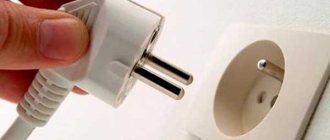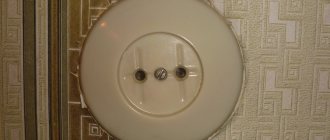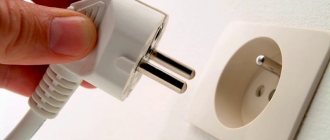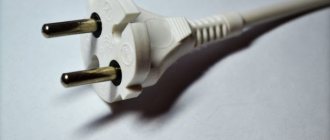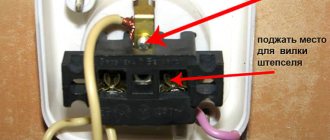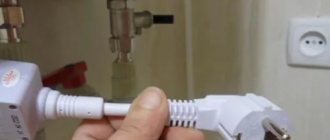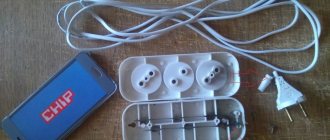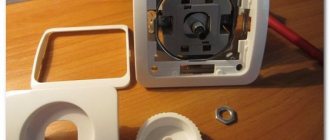If an outlet sparks, then first of all you need to look at exactly when the sparking occurs - during operation or when the plug is turned on. It is not difficult to distinguish them - in the first case, it is a long, characteristic crackling sound of an electrical discharge, during which the plug often heats up. In the second case, a loud crack is heard at the moment when the plug enters the socket, and then everything works as usual. Based on this initial diagnosis, a method for further solving the problem is selected.
Why is the socket beeping?
If the socket makes sounds (noise) or buzzes... This means there is poor contact between the wire supplying the socket and the plug that is plugged into the socket. ... Maybe the fork clamps became more loose than they should have been. The result is poor contact between the plug and the socket. The fork may also get hot.
What does it mean if the charger beeps?
Charger power supplies operate at high frequencies. ... This causes the creation of a magnetostrictive effect, due to which the ferrite transformer begins to vibrate with an increased frequency. It is for this reason that the charger makes a strange squeaking noise, similar to ultrasound.
Why does the charging unit beep?
Why does the power supply start beeping loudly?
You can simply damage the high-frequency transformer or its mountings physically. One unfortunate blow or fall may be enough for this. In this case, visually the power supply will be in perfect order, and there may be no visible damage to it at all.
Why is the block beeping?
The unit may squeak when the winding of the RF choke or transformer is weakened. ... The power supply consists of two power supplies: a standby voltage of +5 V with a separate pulse converter and a low-power transformer, and a second power supply of +5V, +12V, -12V.
What could be cracking in an outlet?
The contacts in the socket often begin to crack if they are worn out. As a rule, this happens the moment you insert the plug into the outlet. Contact wear may also appear in new sockets if a low-quality alloy was made inside them.
How to make sound when charging iPhone?
Many users are interested in the question: how to set a special sound for charging on an iPhone. ... To do this you need:
- Go to “Teams”, then “Automation”.
- Click on “Add new automation”.
- After that, add the “Speak” action.
- In the “Text” menu we write our text.
Why does my laptop charger beep?
A squeaking sound when charging a laptop may be the result of exposure to alternating current on parts that are energized. A frequency of 50 Hz means that in one second the current manages to “bypass” the current-carrying parts 50 times and at least minimally change their position.
Is there something beeping on your laptop?
So, the laptop beeps once when loading, and the sound is short - this means that no errors were detected in the system. Two short beeps indicate that a RAM parity error has occurred, or you have not turned off the scanner or printer. Three short beeps – an error in the first 65 KB of RAM. ... Five signals - faulty processor.
What to do if the system unit beeps?
What to do if the system unit beeps:
- We check the correct connection of peripheral devices - mouse, keyboard, printer, etc. ...
- after disconnecting the computer from the network, check the connections to the connectors on the motherboard, remove the video card and RAM modules
Why does the switching power supply beep?
It beeps because the operating frequency of the converter is in the audible frequency range. Under load, the frequency increases to raise the sagging voltage and ceases to be audible. To eliminate the effect, IMHO it is necessary to reduce the number of turns of the throttle.
Why does the throttle squeak?
When the current-carrying conductor in the magnetic field begins to move, mechanical vibrations arise in the inductor, which our ears perceive as a squeak. If the inductor begins to squeak without load, then most likely an interturn short circuit has occurred in it and such an inductor must be replaced.
What to do if the socket starts smoking?
So, the algorithm of actions:
- the first thing to do is to soberly assess the scale of the tragedy. ...
- if there was no fire, but the socket is clearly out of order, you should definitely call an electrician;
- it is necessary to turn off the power supply to the apartment/house. ...
- You must definitely call the fire department, describing in detail what is happening; /li>
Why does it spark when you insert a plug into a socket?
Why does it sometimes spark a little when you insert or remove a plug into a socket? There may be two reasons for this: either poor contact between the electrodes of the plug and the contacts of the socket, or the connected device requires a current greater than the socket can provide (called current overload).
What to do if the socket sparks?
The clamping jaws weaken and cannot compress the electrodes with sufficient force. The consequence is weakening of contact and heating. If this phenomenon is noticed in time, the outlet can be saved (how to fix an outlet). Then it needs to be disassembled, inspected and its lips tightened with pliers for tighter contact.
Causes of aggressive behavior in cockatiels
By opening its wide beak and making terrible sounds, the parrot is trying to protect. This is a big part of the adaptation period. The maintenance process is not always easy: Cockatiel is a broken bird, and not being new will take a long time. The nymph may sing at other times in his life. Increased irritability occurs during passage, illness, adolescence or nesting. Below is a list of the main reasons why Cockatiel hisses, bites and attacks.
Fears
If a bird is afraid, it can behave in different ways: chasing in a corner or attacking, screaming, beating its wings. Fear triggers the self-preservation instinct and a defensive reaction occurs. The bird warns of its intention to attack and passionately feathers. If the opponent does not withdraw, he will be in trouble.
What or who can scare a parrot?
- unknown elements;
- New toys;
- flowing curtains;
- noise from household appliances;
- pets;
- Forced swimming;
- Healing procedures;
- Pressing the action button of people in the fight against the bird.
If the adult has changed ownership, the parrot will be stressed out in the new environment. In the beginning, the parrot will respond reluctantly to even moderate attempts at domestication. Even the gentle hand-drawn ability to tab, squeak and bite.
A word of warning! Corella remember the man who hurt them. They can take revenge on a person who feels discomfort. This vintage animal is very difficult to tame.
Sick
Sometimes it can be difficult to understand why the Cockatoo began to bite if it was pleasant and comfortable. During illness, the bird will have additional reasons for aggression. Physical discomfort, weakness, pain - and now the parrot is not like her. He doesn't respond to petting, he doesn't respond to toys, he rolls over, he sleeps a lot.
What to do if the outlet makes strange noises?
That’s why, if you hear a crackling sound in an outlet or notice sparks in it, we advise you not to tempt fate, but to immediately fix the problem. If the problem is in the product itself, it is better to replace it with a new one. If it's a wiring issue, call an electrician. High-quality sockets in a working network should not crack or spark.
What does it mean if the outlet makes strange noises?
If the socket makes sounds (noise) or buzzes... This means there is poor contact between the wire supplying the socket and the plug that is plugged into the socket. Note that noise appears when a load is connected. There is no noise without load. ... The next possibility is that the contacts between the wire and the terminal blocks of the socket are burnt.
Why does a socket crack without a plug?
The reason is simple - plugs from switched-off devices are inserted into some sockets, and plugs from switched-on devices are inserted into others, on the contrary. Take a computer for example - usually all its peripherals are connected to one surge protector with 5-6 outlets. This is the system unit itself, a monitor (or even two), speakers, a printer, a router - maybe something else is connected.
What could be cracking in an outlet?
Sockets crack for several reasons: Exceeding the power for which the electrical installation product is designed. Long service life and natural wear of connectors. Loosening of contact clamps.
How can an outlet light up?
Main causes of fires
As simply as possible, a socket can be represented as two wires (contacts) placed in a plastic box and not interacting with each other in any way. When, for example, a plug is inserted into it, the metal connects both wires and current begins to flow into the electrical appliance.
What does it mean if the socket hisses?
Sockets crack for several reasons: Exceeding the power for which the electrical installation product is designed. Long service life and natural wear of connectors. Loosening of contact clamps.
Why are the wires ringing?
The noise comes from the fact that alternating current with a frequency of 50 Hz creates an alternating magnetic field, which forces individual cores in the wire (especially steel ones - in wires of the AC-75, 120, 240 types) to vibrate, they seem to collide with each other, and we hear a characteristic noise.
Why does the socket crack when plugged in?
If a cracking sound is heard when the plug is in the socket, then this is already a sign of poor contact in some part of the electrical circuit. Often, over time, the surface of the plug or the socket itself heats up, or even all at once.
Is it possible to turn off the power to the outlet?
When working with electrical appliances, you must follow safety rules to avoid electric shock. Therefore, before connecting the outlet, it is necessary to disconnect the electrical wiring. This can be done in the distribution panel by turning the toggle switches of the machines to the “off” position.
What to do if the socket shorts?
The result is poor contact between the plug and the power source, which causes the socket to spark when the plug is turned on. The solution to this problem is simple - replace Chinese products with more expensive ones. We recommend giving preference to manufacturers of sockets and switches such as ABB, Legrand and Jung.
Inconsistency of standards
One of the simplest causes of sparking can be considered a difference in standards between the electrical plug and the outlet itself. The fact is that since the times of the USSR there have been two main standards: Soviet (C) and Schuko. The difference between them is the cross-section of the plug electrodes. At first glance, the difference is not too great, but at the same time, this run-up becomes the reason for loose contact between objects. If the Shuko plug fits tightly into the Soviet sockets, there will be no problems, but feedback may cause the socket to spark when the plug is turned on.
The optimal solution can be achieved by replacing old USSR electrical wiring elements with modern standards.
Why do the speakers hiss like Aunt Clara?
Contacts
Telephone:
Opening hours: Mon-Fri from 10:00 to 19:00 Moscow time
For any questions, write to: [email protected]
If you have difficulties with your order:
Our address: 105005, Russia, Moscow, st. Radio, 12 page 2
Hush, auntie, you are not a snake! Or. No? I hope I'm not the only one who talks to my equipment and gives it nicknames.
Recently Aunt Clara started hissing, which really puzzled me. And there was something to be surprised about: a respected brand, Bose, of course. And suddenly this!
Of course, I took the speaker to a service center, where they repaired it. It turned out that I was a fool myself and pinched the cable with which I connected the phone (damn this wired technology!), with the corner of the table. However, I need to write about something on this blog! So today I will share my experience and tips on what to do if the speakers suddenly hiss. Of course, my case is only one situation; to be objective, I will also consider other reasons from the practice of my colleagues.
Why do the speakers hiss?
If the speakers decide that they are cobras, you must first ask what is the reason for this behavior . After scouring thematic forums, I identified several possible ones:
- Corrosion on the speaker if the speaker is built into the car. It appears due to moisture, which inevitably comes from open doors. It threatens both coastal residents and motorists from rainy St. Petersburg.
- Broken audio jacks . Over time, the socket “wears out”, and even very high-quality equipment can develop a gap between the plug and the connector. So hissing occurs when the plug is in the wrong position, especially if it is twisted at that moment.
- Cable condition . Of course, this reason only applies to wired speakers, but still. Before sinning on the equipment, look at the cord - perhaps there are creases, abrasions, etc. on it. Damaging a cable is actually quite easy, especially if there is a dog in the house or the wire has been crushed by furniture, as I did (don’t do that!).
- Once again the cable is to blame. The reason is its length. It is not recommended to use wires longer than 5 meters , especially since this is not required for a home. If for some reason the speaker is far from the player, it is better to use a Bluetooth connection. A regular extension cord can also cause sound distortion.
- The cable is hanging loose . Yes, wired acoustics won’t be a hassle, as I understand from reading the forums. This time because the wire is dangling. People touch it, there is a draft from the window. In that case, the person solved the problem by taping the wire to the chair.
- Location of audio connectors . There is only one on the laptop, on the side. There are several of them on the system unit: on the front and rear panels. Usually people connect the speaker from the front - it’s so familiar and convenient. But the sound quality is much better on the back side - the port is not as worn out there, and technically the sound is cleaner.
- In addition, the hissing sound may be caused by a coil of snakes. More precisely, due to tangled wires from other devices.
Is it really all evil from the cable? Of course not. Wireless models also cry. For example, from incorrect system settings . Windows versions 8 and later automatically install drivers. This, of course, makes the user’s life easier, but it makes it impossible to delve into the panel and change the settings.
But we need to talk about this in the context of a specific problem.
Also, the causes of hissing include a worn speaker . Previously, I already wrote about how harmful it is to turn the volume up to full and what this can lead to. True, the conversation was about headphones, but even in speakers, the speaker is not immortal.
To check who is to blame for the bad sound - the system unit or the speaker - try connecting the latter to different devices. If this is the case, then it is better to contact the service center, and under no circumstances! do not repair it yourself. Equipment disassembled by miracle engineers will not be accepted under warranty.
In addition to problems with speakers and wires, grounding, also called grounding of electricity, interference Usually located in the basement of a residential building. All sockets are connected to grounding, which means all devices work correctly. But there is one caveat. If for some reason the speaker and the player are connected to different outlets, unequal resistance is created and a “stray” current appears between them, which introduces extraneous noise.
And the placement of the speakers , of course. I also wrote about this once. By skillfully deploying a pair of speakers, you can create stereo sound no worse than in a movie theater. And you can ruin it. It depends on how carefully you followed the instructions.
What to do if the speakers hiss
Before you panic, you should diagnose and understand the reason why the speakers hiss when they are turned on. To do this, you don’t have to be a radio engineer; you just need to follow the recommendations below.
- Make sure the problem is with the speaker - try connecting it to several devices.
- If it is turned on, but there is no sound, perform foolproofing: make sure that the sound is not turned up to the very minimum (and this has happened to many, I have come across it myself more than once).
- If the speaker is a computer and the noise resembles an echo, crackling, etc., check to see if the sound effects are turned on. Even if you definitely didn’t change the settings, they could have been changed by some program running as an administrator.
- Check to see if the wire is inserted into the correct connector. Perhaps life simply didn’t work out because it was plugged into an adjacent input not intended for audio.
- Check system problems like communication parameters. In the latest versions of Windows, when talking on Skype, the speakers are automatically muted so as not to interfere with the conversation. But something can go wrong, and they may work worse without communicating over the network.
- Make sure there are no mechanical damages, clean from dust (but without water! A drop is also water). It is better to carefully walk with a barely damp lint-free cloth or brush. Sometimes the dust is simply blown onto the carpet.
- If dancing with a tambourine doesn’t help, test your sound card, maybe that’s the problem.
Screw clamps are loose
Any dismountable product tends to wear out over time. All screws, latches, springs are unscrewed and weakened over the entire period of operation. The result of this, again, is poor contact of the electrodes with the network, as a result of which you can see how the socket sparks on its own (without plugging in the plug).
If the wiring consists of aluminum conductors, then the screw terminals need to be tightened several times a year, because aluminum tends to “leak”, as a result of which the contact weakens, from which it begins to spark. The connectors themselves where the plug is inserted may also be worn out. The plug is fixed using special clamping jaws, which unbend when frequently connected/disconnected. In this case, you need to bend them inward with pliers.
These two reasons are the most popular, and if sparking is detected in time, the situation can be saved by ordinary repairs. If you have already disassembled the outlet, carefully examine all other elements of the structure: perhaps intervention will be required somewhere else.
Video instructions for repairing an outlet that sparks
Why does the machine hum or buzz in the panel under load and what should I do?
Very often we are faced with such a problem as the sudden appearance of an abnormal operating sound from a circuit breaker in the panel room.
A slight hum from an electromagnetic starter surprises few people, and some even consider this effect to be its usual mode of operation, although this is not the case for new devices. So what should you do when your machine buzzes like this or buzzes?
First of all, remember that all machines installed in a panel under normal operating conditions should never make any sounds.
If this sound appears, then first of all decide what it sounds like:
- hum
- buzz
All your further actions will largely depend on this.
Such sounds appear when the machine is energized and under load. That is, current flows through it. Moreover, the greater the load, the louder the machine can make noise.
Let's look at the first fault, namely humming. If your machine makes a sound during operation like a starter or contactor, this indicates a defect or defect.
Do not look here for damage to electrical wiring, bad contacts, etc. A humming machine definitely needs to be changed.
Although this does not mean that his defense will not work as it should.
It can still shut down properly and operate during short circuits.
But how long it will work like this - a month or two, or it will burn out at any moment, you will never know in advance.
Moreover, if in the electrical panel it stands in one tight row with other intact circuit breakers, its sudden damage or ignition will lead to the failure of all neighboring switching devices.
Therefore, it is better not to delay the replacement and immediately buy another one. Do not listen to the advice of those who recommend simply knocking on the machine body with some blunt object.
For example, the back of a screwdriver. Apparently after this the sound disappears.
Replacing a machine is not such a difficult job, and many people do it even under voltage.
Also, do not try to repair or disassemble it yourself. Such modular devices are made disposable and cannot be restored at home.
They are assembled not with screws at all, but with rivets. These rivets can only be drilled out.
If you do this, you will see the following picture inside.
The only thing that can hum here is the trip coil or the electric magnetic release, which is triggered by short circuits.
Its core is constantly in a magnetic field, and if it is not tightened enough, it will actually make a similar sound. Under the influence of an electric magnetic field, the coil enters resonance and begins to vibrate.
Some people notice that when other devices are turned on, the sound disappears. But the point here is not in the device, but in the change in load and induction density. Following it, the vibration amplitude changes, and therefore the hum.
For example, this may be caused by connecting consumers with a pulsed load to the network. Such as power supplies for computers or LED strips.
Turn off the fancy LED backlight and the noise disappears.
You cannot fix this, because some machines initially perceive such a load normally and operate without extraneous noise. Or at least you don't hear them.
And others will get on your nerves and hum like a transformer.
Don't blame the electricians for this, they have nothing to do with it. You just received a defective product.
Therefore, even if you buy well-known brands (ABB, Hager, Schneider, Legrand), and not cheap IEK or TDM, you can still run into trouble.
Only pre-installation tests and loading the machines with a long-term primary current can save you from this. But 99.9% of users never do this.
With sound in the form of buzzing it’s a little more complicated. If you hear a buzzing from your switchboard, and not a dull hum, urgently look for the cause, otherwise disaster will come to pass.
This sound is caused by a small electric arc that occurs when there is poor contact. This noise may come and go.
Your primary task is to determine the specific location where this sparking source appears by turning off all the machines in the row one by one. At the same time, do not turn off the load from the sockets, otherwise the crackling sound may disappear.
When you have found the culprit, carefully examine his contacts. Unlike the first case (humming), the modular machine itself or its internal components may have nothing to do with it.
As a rule, the culprit is insufficiently good contact at the point where the cable cores are connected to the terminal.
What to do if you examined all the contacts, but did not find any visible traces of sparking or burning? In this case, turn off the voltage in the entire panel room by unclipping the input load breaker.
Next, use a screwdriver to tighten the screw terminals of all switching devices in the panel.
If you have a special insulated electrician's screwdriver, then this can be done without completely cutting off the electricity.
After this, turn on the entire load again. If the sound still does not disappear, then change the culprit machine.
You can’t leave everything as it is, even if there are no visible traces of melting. Do not forget that most often the source of fire in an apartment or house is the electrical panel. And it all starts with a small machine gun.
It is in the switchboard that the entire load is concentrated and all the devices and switching wires are most densely located.
As soon as an open electric arc occurs, it will immediately transfer to all neighboring elements.
By the way, if not quite perfect, but more or less working protection has already appeared against sparking in sockets, in the form of UZM-51MD or UZIS, then the switchboard itself is practically not protected from this in any way.
It should be noted that the work of re-tightening all contacts must be done at least once a year. Even if nothing buzzes or sparks.
Worn wiring
The next reason for an outlet to fail is the deterioration of the electrical wiring in the house (or apartment).
If the diameter of the cores is small, then you should not connect powerful electrical appliances (for example, a microwave), otherwise the line will simply not withstand the current load, as a result of which the outlet will begin to spark. Here you need to first inspect the old current-carrying line and, if necessary, replace the electrical wiring in the house. Correct replacement is carried out based on calculation of the cable cross-section for power and current.
Why is iPhone charging beeping? Is it dangerous?
Like any techie, I am surrounded by dozens of power supplies for charging mobile devices: smartphones, headphones, smartwatches. I try to use only original Apple adapters, but even they sometimes fail.
It happens that during operation of some of them a piercing squeak occurs , which is clearly audible in complete silence: it is annoying during operation and interferes with sleep if the iPhone is charging near the bed.
To understand the nature of the vile sound, I turned to the service center employees to clarify the situation: should I worry?
What could be squeaking inside the power supply?
Standard American iPhone power supply inside
Switching power supplies are used to charge the iPhone and other modern devices. They work more efficiently than regular adapters, so you're unlikely to find any others around you.
To obtain the voltage required for the same smartphone, power supplies have high-frequency transformers .
This component takes electrical current from a relatively low frequency socket (50 Hz) and turns it into high frequency pulses of tens or hundreds of kHz.
If the high frequency transformer is not built to standard or has been damaged during use, it may vibrate and you will hear a high-pitched squeak.
Its frequency is usually close to the upper limit of human hearing (16-20 kHz), which decreases with age. That is why young people most often complain about the vile sound.
Interestingly, the sound can occur not only during charging. To hear it, most often you just need to connect the power supply to the network.
How does the iPhone power supply work?
American power supply connected to the network
In simple terms, the iPhone power supply is needed to create the specified voltage and current .
When you plug it into a socket, the chip passes current through itself to the transformer, which should generate a voltage of 5 V. To do this, it uses pulses.
A special diode is installed after the transformer, which does not allow current to pass in the opposite direction.
Together with a microcircuit that can cut off pulses, it protects the device from voltage surges in the network.
General diagram of a switching power supply in modern smartphones
To stabilize the voltage, a smoothing filter is used. Before it, it is usually at the level of 5-5.05 V, after - a stable 5 V.
After all manipulations, power is supplied to the USB port. Next comes the Lightning cable, which should transmit the whole thing to the iPhone.
Why does the power supply start beeping loudly?
It's really annoying.
Practice shows that new Apple chargers are silent in 99% of cases : a squeak in their operation occurs only after careless use.
You can simply damage the high-frequency transformer or its mountings physically. One unfortunate blow or fall may be enough for this.
In this case, visually the power supply will be in perfect order, and there may be no visible damage to it at all.
Another thing is fake power supplies or cheap chargers without certification:
In the center is a fake power supply for the iPhone - Apple has never made European chargers in the shape of American ones
Any of their components may not be manufactured to standard, so they may make strange sounds or not work at all.
Even if everything is fine with such charging at first, the situation may change after just a few days of use.
What does such beeping mean for the iPhone itself?
Such a charger can still be used.
The most important thing: the presence of extraneous sound is not dangerous .
The Apple proprietary power supply is designed in such a way that it is either 100% safe or does not work at all.
The service center confirmed that they have not seen a single iPhone that was damaged by original manufacturer accessories.
The situation is the same with branded analogues, but nameless crafts can damage the device even without a squeak.
How to fix the power supply so it doesn't squeak
To deal with the problem, you will have to buy a new charger
. No way.
Repairing standard iPhone power supplies is too time-consuming, troublesome and expensive.
Moreover, it is almost impossible to even disassemble them and put them back together without visible damage to the case.
If your iPhone's power supply is already beeping, it means that not everything inside it is working well. It's time to think about a replacement, although he can cope with his duties for more than one month.
Current overload
Another, no less banal reason that the outlet sparks is carelessness when purchasing a new device. Each product has its own letter marking, as shown in the photo below. The rated current must be indicated on the case (for example, 16 A). This means that the current load from electrical appliances should not exceed 16 amperes. Otherwise, problems may arise, including sparking of the product when a plug is inserted into it. If you connected the sockets together with a cable and noticed that one of them heats up when you remove or plug in the plug, then the electrical installation was incorrect (for example, you chose too small a cross-section of wires or did not tighten the cable properly). It is advisable not to connect adjacent sockets to each other, but to branch wires to each electrical point from the distribution box.
To choose the right electrical accessories, remember the following calculation: 1 ampere can withstand no more than 220 W of power. In total, a 16-amp device can withstand approximately 3.5 kW, which is quite enough to install a washing machine or an electric boiler.
A few more important points should be noted here. If you buy, for example, a double socket and it says 16A, this does not mean that each socket can handle that current. In this case, the rated current is divided between both sockets. The second, no less important point is to take into account the current parameter when connecting the extension cord. Very often, people connect the carrier to 5 outputs, each of which operates a powerful electrical appliance. If the power exceeds the maximum possible, the product will begin to spark and quickly fail!
Electrician UFA
Greetings to all visitors to my site. My name is Akim, I am an electrician with more than ten years of experience in the electrical installation industry. I have secondary specialized and higher education behind me. In addition to all this, I have completed and successfully delivered more than a thousand projects. Below are original photographs of my work, with a partial list of the services I provide. I will reinforce your confidence that this is a photo of my work, and not a banal copy-paste (theft). And the VIDEO section will help me prove it, where I post video reviews of my objects. There is also a section of text reviews with more detailed photo reporting. And finally - the REVIEWS section, where you can communicate personally with my clients using social media. VKontakte network by simply going to their pages. Are there any doubts left? Then look at the pictures.
⇓ Click on the photo to enlarge it ⇓
I provide services for assembling panels of any complexity (ShchU, ShchUR, ShchR, ShchO, etc.). I will try to post a small part of the work on assembling electrical panels below.
⇓ Click on the photo to enlarge it ⇓
Also, replacement/installation of meters, automatic switches (AB), differential circuit breakers (RCBO), differential switches (VD, RCD) and so on... Below in the pictures are details of individual fragments of my electrical panels so that you can be convinced of the quality of execution of all the little things.
⇓ Click on the photo to enlarge it ⇓
I also consider the marking of its façade (front) part to be an important part of a well-assembled electrical panel. This is necessary not only for banal convenience, but also for safety, so that owners can quickly navigate the electrical panel in case of an emergency.
I have developed a convenient type of marking for my clients with color and text designation of groups. Let's look below.
⇓ Click on the photo to enlarge it ⇓
Wiring of cores in distribution boxes using all modern methods, depending on the technical conditions of the project or the customer’s request. Welding, crimping, soldering, PPE, WAGO. Excludes any bolted connections due to their annual maintenance requirements.
⇓ Click on the photo to enlarge it ⇓
Carefully laying cable routes parallel to building structures is not just my unnecessary perfectionism and aesthetics. This type of installation is convenient and intuitive, easy to read the diagram, convenient for maintenance, and also convenient for documenting in photo reports, some of which I will give below.
⇓ Click on the photo to enlarge it ⇓
An integral part of high-quality electrical installation is also clarity and rigor in wall gating. There should be no diagonal or wavy grooves. Everything is strictly parallel to the building structures. That is, either horizontally or vertically. Deviation from these standards entails a number of problems associated with the unknown - how and where this or that route passes, behind already plastered walls, when the electrical wiring is completely hidden. You won’t be able to hang shelves, pictures, or kitchen units with peace of mind. There will be constant risks of breaking the cable. I attach pictures from high-quality gating below.
⇓ Click on the photo to enlarge it ⇓
Using the most advanced tools for more comfortable, high-quality and faster work. Diamond drilling of reinforced concrete structures for installation of distribution and installation boxes. Wall chipping without dust or impact equipment. This plays a huge role in panel houses, where it is not recommended to disturb the concrete structure.
Carefully!
By choosing an electrical specialist and electrical installation work, trying to save a lot, or solving the problem yourself, you endanger not only yourself, but also the people around you. Thus, just this winter in Ufa, several private houses were destroyed in fire due to electrical wiring fires. And in Russia these numbers increase to hundreds, not to mention the fires that were extinguished in time.
Fires due to poor quality or outdated electrical equipment
How to fix a switch: types of devices
If you find out that your switch is not working and decide to fix it, then the device must be disassembled. Before this can be done, the power to the network is completely cut off. To do this, turn off the power at the switchboard automatically, and then check the voltage status at the output.
If you were unable to de-energize the line you needed, then it is best to disconnect the entire apartment from power. Only after this can you begin repairing the switch. But that is not all. Before removing the switch, it is necessary to determine its type.
What could the switch be:
- Single-key;
- Two-key;
- Pass-through, or three-key;
- Spinning;
- Dimmer – switch;
- Touch switch.
Today there is a wide variety of switch models on the market, but most users have conventional key devices.
This is interesting: Scheme of a diode bridge with two diodes and two capacitors: illustrating in general terms
How to seal grooves in a wall with electrical wiring
To decide what is better to seal the grooves after laying the wiring, you need to familiarize yourself with the features of working in walls made of different materials. To seal the holes, you need a spray gun, a tank for mixing mortar, a trowel, a brush and a spatula.
Concrete
Before you start sealing the grooves, you need to generously moisten the hole itself and the area around it with clean water using the following working equipment:
- a piece of foam rubber or sponge;
- spray;
- wide brush with synthetic bristles.
The trenches are first primed and then sealed with a building mixture. It is applied using a spatula with wide cross strokes. After the substance has hardened, the excess is removed with an iron spatula. Movements should be stroking and smooth. After complete drying, the surface is puttied.
Brick
Carrying out work in brick walls is accompanied by a large amount of dust. Before you start sealing the grooves, you need to remove dust and treat the working surface with clean water.
It is recommended to seal the furrows with alabaster or gypsum mortar. If the groove is deep, it is acceptable to use small pieces of stones soaked in mortar. Next, the remaining voids are carefully filled with mortar using a trowel.
Monolithic wall
The work in this case is similar to work in a wall made of concrete or aerated concrete. The recess is filled with viscous putty. The solution fills the cavity as tightly as possible.
Troubleshooting procedure
All sockets in the apartment do not work
Possible reasons for such a malfunction can be formulated as follows:
- there is no general power supply to the apartment;
- there is a malfunction in the input distribution panel;
- All sockets in the apartment are powered from the panel from one group, the wiring of which was damaged or de-energized.
The general absence of tension is easily determined. If the input circuit breaker is turned on, the outgoing circuit breakers are also turned on, but the electrical appliances in the apartment do not work (including in the kitchen), and there is no light in any room, which means there is no power at all. We are finally convinced of this by checking with an indicator the presence of voltage at the input circuit breaker.
If there is voltage at the input terminal of the machine and there is no voltage at the output terminal, turn off and turn on the machine again. If nothing has changed, the switch is faulty and must be replaced.
In the same way we check all outgoing switches. Among them we find the one from which the socket group is powered. If voltage is supplied to the line, but the socket group does not work, you should look for a broken wire. Power supply to the socket group can be provided through distribution boxes or via a cable. In the first option, you need to open the first box from the panel and ring the wires to determine the location of the wire break. In the second option, the socket closest to the panel is opened, the wires coming from the panel are disconnected.
Sockets do not work in one or two rooms
If a distribution panel is installed that has an input circuit breaker and several outgoing circuit breakers, we try to determine which of the circuit breakers supplies the section of the wiring where the sockets do not work. Most often, socket and lighting wiring in one room or two rooms are combined into one group, powered by one machine. Sometimes sockets are installed on the same wall in different rooms. We check whether all machines are turned on; if so, we check the presence of voltage at the input and output of the machines. If there is a disabled machine, we turn it on. If the lowered toggle switch in the panel does not rise, there may be two reasons:
- the mechanical drive of the machine is faulty and the device must be replaced;
- The circuit breaker has just been tripped by the protection and the thermal release has not yet cooled down.
In the first case, you need to purchase a machine of the required rating and replace the faulty one with it. In the second case, we look for the location of the damage. Since the wiring in modern apartments is hidden, access to the wires is possible only in panels, junction boxes (if they are installed and not walled in the wall) and in the sockets themselves.
Armed with a multimeter, we measure the resistance between the phase and neutral wires of the found group, of course, turning off the voltage. We make this measurement from the input panel. When detected, we try to trace the route of the electrical wiring group that interests us. You need to find a junction box that has two wires coming into it, indicating a short circuit. If the box found has a lid, open it, remove the insulation from the twists, disconnect the wires and release the pair that showed a short circuit. We measure the resistance of this pair towards the input panel. A resistance close to zero means that the damage is located in the wiring section between the input panel and the junction box. If it is not possible to remove the wires, all that remains is to lay new wiring in this area.
Damage to hidden wiring rarely occurs on its own. There are often situations when a wiring fault is discovered after repair. When drilling holes in walls, for example to hang a cabinet or shelf, the wiring or its insulation may be damaged. To prevent this from happening in the future, we recommend that you read our advice on how to do this.
A short circuit can occur after the electrical wiring is flooded, when heating or water supply pipes break, or after a flood in the bathroom of the upstairs neighbors. The wiring insulation may have minor defects that do not appear while the wires are dry. When moistened, cement dust with water forms a conductive medium, resulting in a short circuit, insulation burnout and sintering of wires together.
First actions
The question of what causes cracking inside the microwave food heating chamber has more than one answer. First you need to understand the structure of the unit. Understand what is happening in it, what factors lead to unpleasant phenomena. And then take active steps to repair the stove.
But not everything can be replaced on your own. Some operations are performed exclusively in service workshops; it will be difficult to do them with the stove at home. Experience shows that you can do without expensive microwave diagnostics if you know where to look for the cause of the malfunction.
